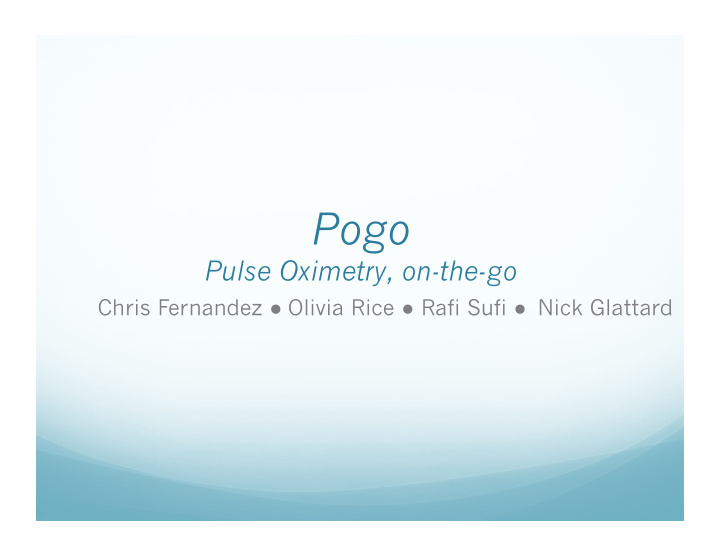



Pogo Pulse Oximetry, on-the-go Chris Fernandez ● Olivia Rice ● Rafi Sufi ● Nick Glattard
Progress to date GSM Network
Problem Statement Last semester, a portable, cellular network enabled, pulse oximeter device was prototyped and tested. Although the device met key client specifications, an application and interface are needed for viewing patient oximetry data in real time.
Product Design Specs Design a computer program that: Receives and stores patient data from Pogo Displays a waveform sample, pulse rate, SQI Provides real-time alerts to aide in decisions Is extendable to monitor several patients simultaneously
Design Alternatives
Web Application Workflow
Pogo Saves patient oximetry data Periodically transmits data packets to Xively Utilizes secure API key to initiate websocket Data contains no identifiable patient info
Heroku Cloud platform as a service (paas) PostgreSQL database management system Utilizes partitioned, relational data tables:
Django Django is a python web framework for rapid development of database-driven applications Open-source Platform agnostic Widely supported Highly Modular – MVT architecture
Model – the data access layer Access the data from database Configuration of data – behaviors and relationships between datasets
Template – the display logic layer “Presentation layer” Syntax similar to HTML
View – the business logic layer Logic for getting data in and out of database Takes web request and returns a response
Bootstrap Implementing interface with Twitter Bootstrap framework Incorporates CSS, HTML5 and JavaScript Currently prototyping interface locally:
Future Work Gather Physician feedback on user interface Incorporate D3 data visualization libraries Validate and test pulse oximetry data Configure Django framework with PostgreSQL database Optimize database partitions Verify Django script that retrieves data from Xively API
Special Thank You Dr. Fred Robertson Dr. Amit Nimunkar Department of Anesthesiology Law & Entrepreneurship Clinic
Questions?
Recommend
More recommend